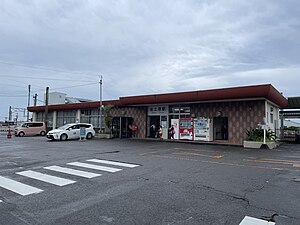Sadowara Station
Sadowara Station 佐土原駅 | |||||
|---|---|---|---|---|---|
 Sadowara Station in 2023 | |||||
| General information | |||||
| Location | Japan | ||||
| Coordinates | 32°01′21″N 131°28′38″E / 32.02250°N 131.47722°E | ||||
| Operated by | |||||
| Line(s) | ■ Nippō Main Line | ||||
| Distance | 326.7 km from Kokura | ||||
| Platforms | 1 side + 1 island platforms | ||||
| Tracks | 3 + 1 passing loop and 1 siding | ||||
| Construction | |||||
| Structure type | At grade | ||||
| Accessible | No - island platformed accessed by footbridge | ||||
| Other information | |||||
| Status | Staffed ticket window (outsourced) | ||||
| Website | Official website | ||||
| History | |||||
| Opened | 11 September 1920 | ||||
| Previous names | Hirose (until 1 July 1965) | ||||
| Passengers | |||||
| FY2016 | 1,075 daily | ||||
| Rank | 155th (among JR Kyushu stations) | ||||
| |||||
Sadowara Station (佐土原駅, Sadowara-eki) is a railway station in Miyazaki City, Miyazaki Prefecture, Japan. It is operated by of JR Kyushu and is on the Nippō Main Line, and until 1984, was a junction for the now closed Tsuma Line.[1][2]
Lines
The station is served by the Nippō Main Line and is located 326.7 km from the starting point of the line at Kokura.[3]
Layout
The station consists of a side and an island platform serving three tracks at grade. Track/platform 1, directly access from the station building, is a dead-end siding that only serves trains heading to/from the direction of Miyazaki to the south. The island platform with tracks 2 and 3 is accessed by a footbridge. A passing loop runs between tracks 1 and 2. The station building is a modern flat-roofed concrete structure which houses a waiting area, a staffed ticket window, an automatic ticket vending machine, and SUGOCA card reader and charge machine. Adjacent to the station building and beside track 1 is a container terminer, formerly served by rail but now part of the Sadowara ORS (off-rail station) which only uses trucks.[2][3][4]
Management of the passenger facilities at the station has been outsourced to the JR Kyushu Tetsudou Eigyou Co., a wholly owned subsidiary of JR Kyushu specialising in station services. It staffs the ticket booth which is equipped with a POS machine but does not have a Midori no Madoguchi facility.[5][6]
Adjacent stations
| « | Service | » | ||
|---|---|---|---|---|
| Nippō Main Line | ||||
| Hyūga-Shintomi | Local | Hyūga-Sumiyoshi | ||
History
In 1913, the Miyazaki Prefectural Railway (宮崎県営鉄道) had opened a line from Miyazaki northwards to Hirose and by 1914, to Tsuma. After the Miyazaki Prefectural Railway was nationalized on 21 September 1917, Japanese Government Railways (JGR) undertook the subsequent extension of the track. In the first phase of expansion, the track was forked northwest and north. The track heading northwest to Tsuma was sectioned off and designated as the Tsuma Line (妻線). A new track was laid heading north from Hyūga-Sumiyoshi to Takanabe which opened on 11 September 1920. This new stretch and the rest of the track south to Miyazaki became part of the Miyazaki Main Line. On the same day, Hirose on the Tsuma Line track was closed and this station was opened at the junction of the Tsuma and Miyazaki Main Line. It took on the name Hirose but was renamed Sadowara on 1 July 1965. Expanding north from Takanabe in phases and joining up with other networks, the track eventually reached Kokura and the entire stretch from Kokura through Hirose to Miyakonojō was redesignated as the Nippō Main Line on 15 December 1923. On 1 December 1984, the Tsuma Line was closed, leaving the Nippō Main Line as the only line to serve Sadowara. With the privatization of Japanese National Railways (JNR), the successor of JGR, on 1 April 1987, the station came under the control of JR Kyushu.[7][8][9]
Passenger statistics
In fiscal 2016, the station was used by an average of 1,075 passengers daily (boarding passengers only), and it ranked 155th among the busiest stations of JR Kyushu.[10]
See also
References
- ^ "JR Kyushu Route Map" (PDF). JR Kyushu. Retrieved 23 February 2018.
- ^ a b "佐土原" [Sadowara]. hacchi-no-he.net. Retrieved 20 May 2018.
- ^ a b Kawashima, Ryōzō (2013). 図説: 日本の鉄道 四国・九州ライン 全線・全駅・全配線・第6巻 熊本 大分 エリア [Japan Railways Illustrated. Shikoku and Kyushu. All lines, all stations, all track layouts. Volume 6 Kumamoto Ōita Area] (in Japanese). Kodansha. pp. 55, 86. ISBN 9784062951654.
- ^ "日豊本線 佐土原駅 国鉄の薫り" [Nippō Main Line Sadowara Station]. 14 March 2014. Retrieved 20 May 2018. Blog entry with good photographic coverage of station facilities.
- ^ "鹿児島支店内各駅" [Stations within the Kagoshima Branch]. JRTE website. Retrieved 20 May 2018.
- ^ "佐土原駅" [Sadowara Station]. jr-mars.dyndns.org. Retrieved 20 May 2018. See images of tickets sold.
- ^ Ishino, Tetsu; et al., eds. (1998). 停車場変遷大事典 国鉄・JR編 [Station Transition Directory – JNR/JR] (in Japanese). Vol. I. Tokyo: JTB Corporation. pp. 228–9. ISBN 4-533-02980-9.
- ^ Ishino, Tetsu; et al., eds. (1998). 停車場変遷大事典 国鉄・JR編 [Station Transition Directory – JNR/JR] (in Japanese). Vol. II. Tokyo: JTB Corporation. pp. 758–9. ISBN 4-533-02980-9.
- ^ Imao, Keisuke (2009). 日本鉄道旅行地図帳 12号 九州 沖縄―全線・全駅・全廃線 [Japan Rail Travel Atlas No. 12 Kyushu Okinawa - all lines, all stations and disused lines] (in Japanese). Mook. pp. 62–3. ISBN 9784107900302.
- ^ "駅別乗車人員上位300駅(平成28年度)" [Passengers embarking by station - Top 300 stations (Fiscal 2016)] (PDF). JR Kyushu. 31 July 2017. Archived from the original (PDF) on 1 August 2017. Retrieved 3 March 2018.
External links
- Sadowara (JR Kyushu)(in Japanese)

